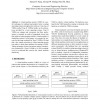Free Online Productivity Tools
i2Speak
i2Symbol
i2OCR
iTex2Img
iWeb2Print
iWeb2Shot
i2Type
iPdf2Split
iPdf2Merge
i2Bopomofo
i2Arabic
i2Style
i2Image
i2PDF
iLatex2Rtf
Sci2ools
USENIX
2003
2003
Operating System Support for Virtual Machines
Abstract: A virtual-machine monitor (VMM) is a useful technique for adding functionality below existing operating system and application software. One class of VMMs (called Type II VMMs) builds on the abstractions provided by a host operating system. Type II VMMs are elegant and convenient, but their performance is currently an order of magnitude slower than that achieved when running outside a virtual machine (a standalone system). In this paper, we examine the reasons for this large overhead for Type II VMMs. We find that a few simple extensions to a host operating system can make it a much faster platform for running a VMM. Taking advantage of these extensions reduces virtualization overhead for a Type II VMM to 14-35% overhead, even for workloads that exercise the virtual machine intensively.
| Added | 01 Nov 2010 |
| Updated | 01 Nov 2010 |
| Type | Conference |
| Year | 2003 |
| Where | USENIX |
| Authors | Samuel T. King, George W. Dunlap, Peter M. Chen |
Comments (0)

